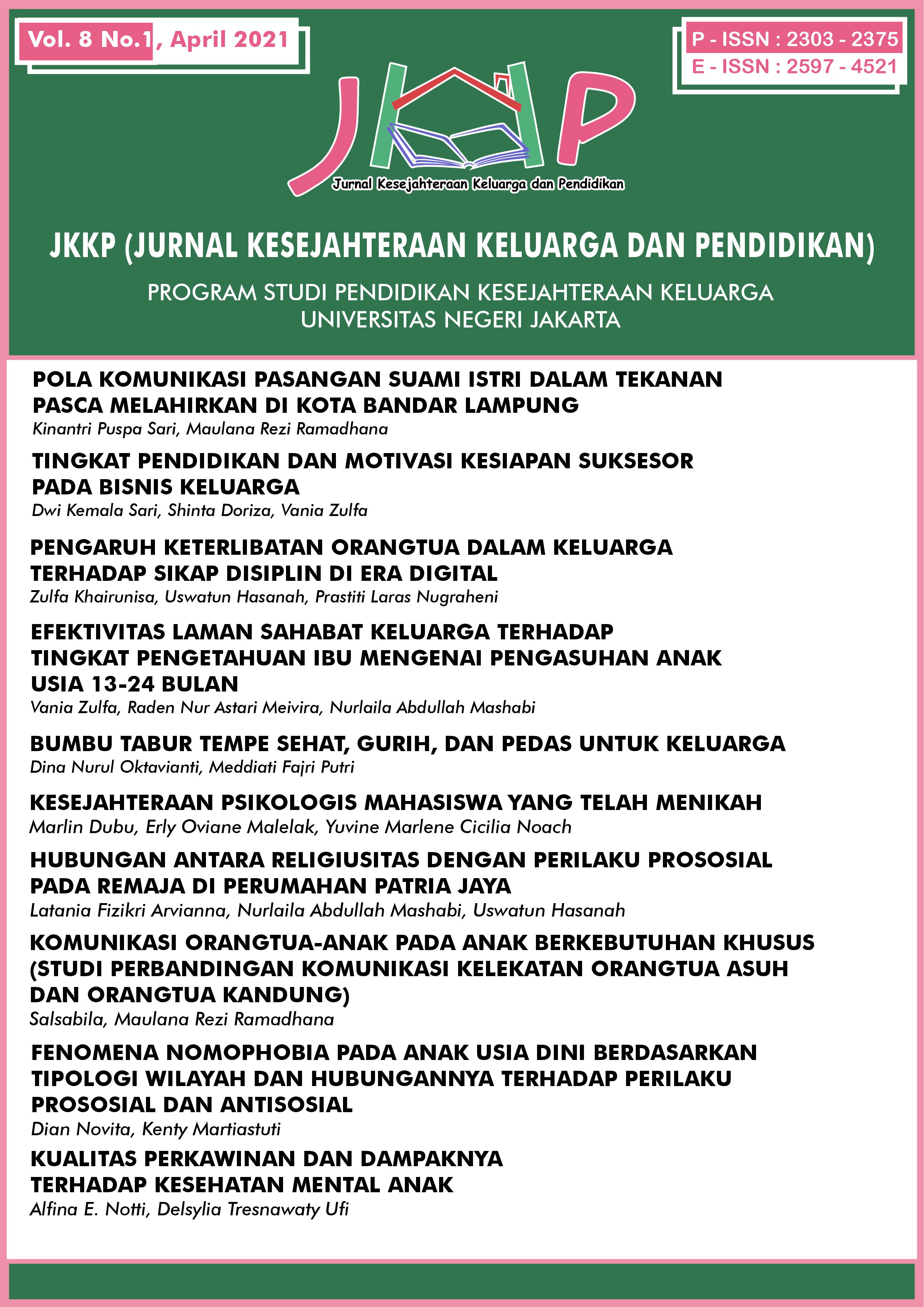KOMUNIKASI ORANGTUA-ANAK PADA ANAK BERKEBUTUHAN KHUSUS (STUDI PERBANDINGAN KOMUNIKASI KELEKATAN ORANGTUA ASUH DAN ORANGTUA KANDUNG)
DOI:
https://doi.org/10.21009/JKKP.081.08Keywords:
kelekatan, keluarga, komunikasi, pengasuhanAbstract
Parent-child communication is the process of sending and receiving messages that occur between parent and child. Parent-child communication is an important factor in forming a good attachment relationship. Without good parent-child communication, there will not be a good attachment relationship. This attachment has a long-term impact from the moment the child is born into the world and throughout his life. Attachment affects a child's emotional, physical and psychological behavior. Children with good attachment will show positive attitudes and behaviors from the results of this attachment relationship, children with bad attachment will show negative attitudes and behaviors. In this study, there is a phenomenon with ABK that is slightly ignored by their biological parents so that children with special needs are cared for by nonbiological parents, therefore the aim of this study is to compare the communication between children with special needs with biological and nonbiological parents. In determining attachment, this study uses Bowbly's attachment theory which states that there are three levels of attachment, namely secure, resistant and avoidant attachment. This research uses qualitative, descriptive methods by applying data collection techniques through in-depth interviews. Interviews were conducted with three key informants, two expert informants and one supporting informant. The results showed that children with special needs have a safe attachment relationship with their nonbiological parents while not safe with their biological parents.
Keywords: communication, family, children with special needs, parenting, attachment
Abstrak
Komunikasi orangtua-anak merupakan proses pengiriman dan penerimaan pesan – pesan yang terjadi di antara orangtua dan anak. Komunikasi orangtua-anak menjadi salah satu faktor penting dalam terbentuknya suatu hubungan kelekatan yang baik. Tanpa adanya komunikasi orangtua-anak yang baik, maka tidak akan terjadi hubungan kelekatan yang baik. Kelekatan ini memiliki dampak yang sifatnya jangka panjang dari sejak anak lahir ke dunia hingga sepanjang hidupnya. Kelekatan berdampak pada perilaku emosional, fisik dan psikis seorang anak. Anak dengan kelekatan yang baik akan menunjukan sikap dan perilaku yang positif dari hasil hubungan kelekatan tersebut begitupun sebaliknya anak dengan kelekatan yang tidak baik akan menunjukan sikap dan perilaku yang negatif. Pada penelitian ini, terdapat fenomena Anak Berkebutuhan Khusus (ABK) yang sedikit diabaikan oleh orangtua kandungnya sehingga ABK diasuh oleh orangtua asuh, maka dari itu tujuan penelitian ini yaitu membandingkan komunikasi kelekatan ABK dengan orangtua kandung dan orangtua asuh. Dalam menentukan kelekatan, penelitian ini menggunakan teori kelekatan dari Bowbly yang menyebutkan bahwa ada tiga tingkat kelekatan yaitu secure attachment (kelekatan aman), resistant attachment (kelekatan cemas) dan avoidant attachment (kelekatan menghindar). Penelitian ini menggunakan metode kualitatif, deskriptif dengan menerapkan teknik pengumpulan data melalui wawancara mendalam. Wawancara dilakukan dengan tiga orang informan kunci, dua orang informan ahli dan satu orang informan pendukung. Hasil penelitian menunjukan bahwa ABK memiliki hubungan kelekatan yang aman dengan orangtua asuhnya sementara tidak aman dengan orangtua kandungnya.
Downloads
Published
Issue
Section
License
Authors who publish with this Journal agree to the following terms:
- Author retain copyright and grant the journal right of first publication with the work simultaneously licensed under a creative commons attribution licensethat allow others to share the work within an acknowledgement of the work’s authorship and initial publication of this journal.
- Authors are able to enter into separate, additional contractual arrangementfor the non-exclusive distribution of the journal’s published version of the work (e.g. acknowledgement of its initial publication in this journal).
- Authors are permitted and encouraged to post their work online(e.g. in institutional repositories or on their websites) prior to and during the submission process, as it can lead to productive exchanges, as well as earlier and greater citation of published works.
Users/public use of this website will be licensed to CC BY SA
![]()







